Grace Robert. Advanced Blowout and Well Control
Подождите немного. Документ загружается.


356
and honored. The
maximum
annulus pressure at the sufice will be the
fi-acture pressure at the shoe less the hydrostatic column of gas.
Advanced Blowout and Well Control
FLUID
LNLL
AT
1,7C3
m
~~
Figure
8.14
-
Delta Temperature versus Depth
The wellbore schematic for the Amerada Hess Mil Vid #3 is
presented
as
Figure 8.15.
An
underground blowout followed a kick at
13,126 feet. The 5-inch drillpipe parted at the
9
5/8-inch casing shoe at
8,730 feet. During the
fishing
operations which followed, a temperature
survey
was
run
inside the
fishing
string. The temperature survey is
presented
as
Figure 8.16. The 85degree temperature anomaly at 8,700
feet confirmed the underground blowout.
It
is interesting to note that the
temperature decreased below the top of the drillpipe fish
at
8,730 feet.
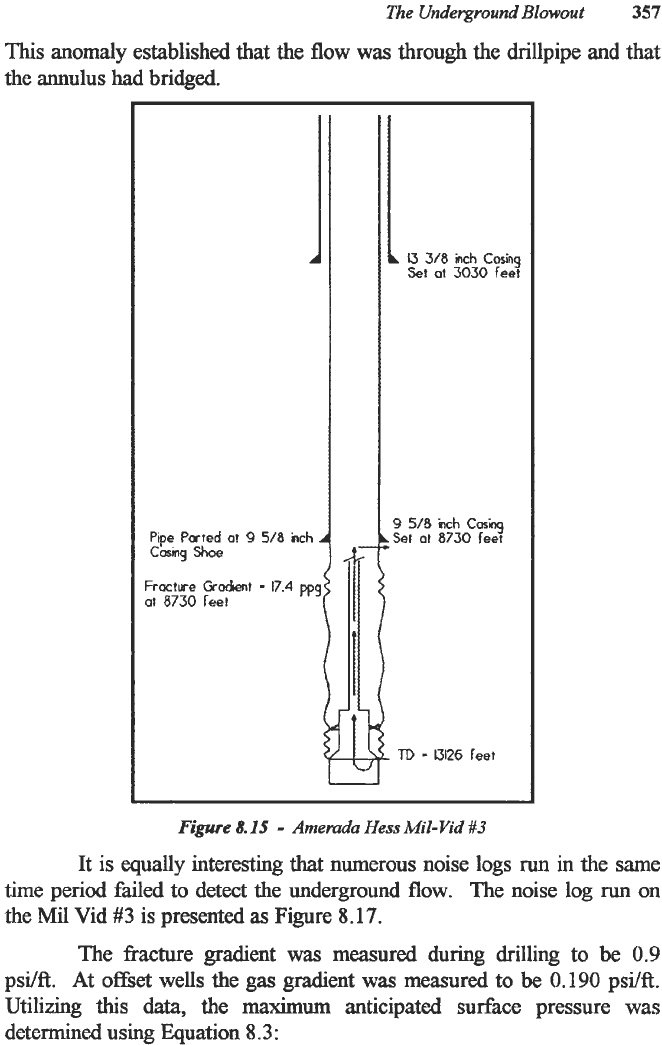
The
Underground
Blowout
357
This
anomaly established that the
flow
was
through the drillpipe and that
tlic
annulus
had
bridged.
Pipe
Parted
at
9
5/8
inch.
Cosmg
Shoe
Fracture
Cocknt
-
17.4
ppg
ai
8730
feet
U
318
inch
Coring
Set
at
3030
feet
9
5/8
mch
Cor.hg
Set
at
8730
feet
TD
-
I3126
feet
Figure
8.15
-
Amerada
Hess
Mil-Vid
#3
It
is equally interesting that numerous noise
logs
run
in the same
time
period failed to detect the underground
flow.
The noise log
run
on
the Mil Vid
#3
is presented
as
Figure 8.17.
The fiacture gradient
was
measured during drilling to be
0.9
psi/ft. At
offset
wells the gas gradient
was
measured to
be
0.190
psi/ft.
Utilizing this data, the
maximum
anticipated surface pressure was
determined using Equation
8.3:

358
Advanced
Blowout
and Well
Control
250
-
240
-
230
-
5%
&E:
8
180
-
170
-
160
-
150
7
TEMPERATURESURVEY
Amaads
Hess
-
Mil-Vi
#3
Figure
8.
16
~~
Mil
Vid
#3
Noise
Log
12.0
Figure
8.17
(8.3)
P,,
=(0.90-0.19)8730
P,,
=
6198
psi
Although
the calculated
maximum
anticipated surface pressure
was
only
6200
psi,
during
subsequent opmtions the surface pressure was
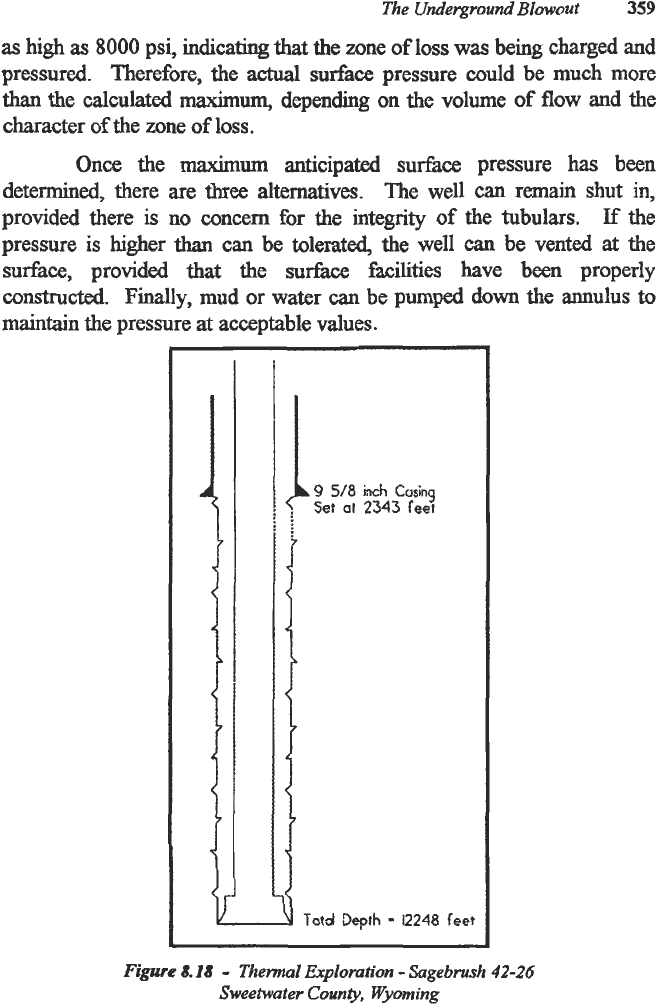
The
Underground
Blowout
359
as
high
as
8000
psi,
indicating
tbat
the zone
of
loss
was
being
charged and
pressured. Therefore, the actual surfixe pressure could be
much
more
than
the calculated
maximum,
depending on the volume of
flow
and the
character of the zone
of
loss.
Once
the
maximum
anticipated
surface
pressure
has
been
determined,
there
are
three
alternatives. The well can
remain
shut
in,
provided there
is
no
concern for the integrity of the tubulars. If the
pressure
is
higher
than
can be tolerated, the well
can
be vented at the
surface, provided that
the
surfixe
facilities have been properly
constructed.
Finally,
mud or
water
can
be pumped down the annulus
to
maintain
the pressure
at
acceptable
values.
u
Totd
Depth
-
12248
feet
Figure
1
It
-
Themral
Explomtion
-
Sagebnish
42-26
Sweetwater County,
Wyoming
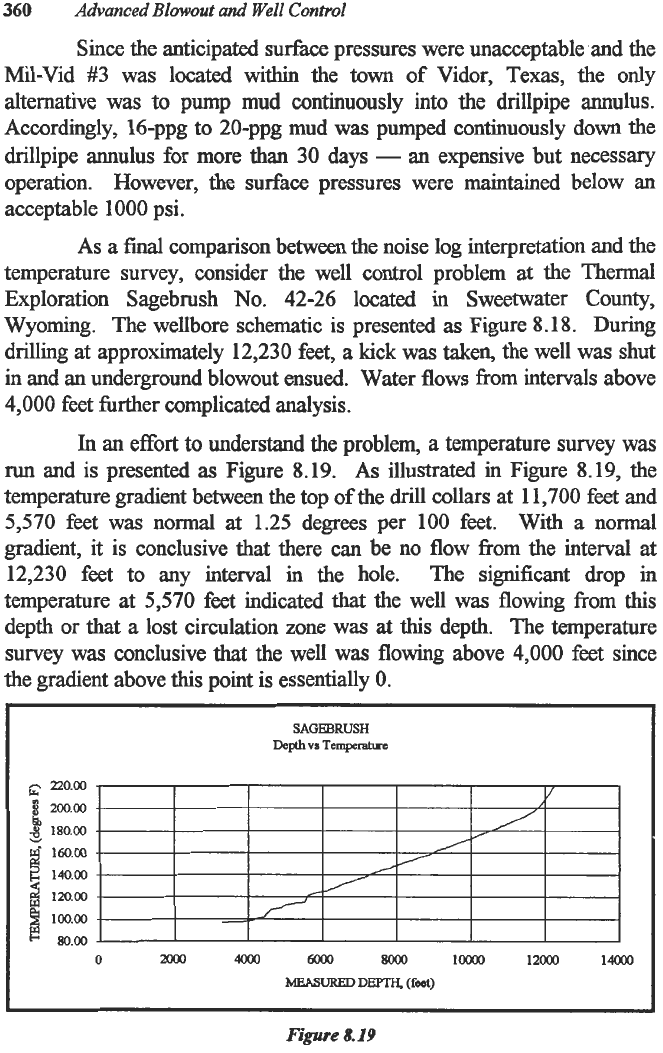
360
Advanced
Blowout
and
Well
Control
Since the anticipated surfsce pressures were unacceptable and the
Mil-Vid #3 was located
within
the
town
of Vidor, Texas, the only
alternative was to pump mud continuously into the drillpipe annulus.
Accordingly, 16-ppg to 20-ppg mud was pumped continuously down the
drillpipe annulus for more than 30 days
-
an expensive but necessary
operation. However, the surface pressures were maintained below an
acceptable 1000 psi.
As
a
final
comparison between the noise log interpretation and the
temperature survey, consider the well control problem at the Thermal
Exploration Sagebrush
No.
42-26 located in Sweetwater County,
Wyoming. The wellbore schematic is presented
as
Figure 8.18. During
drilling at approximately 12,230 feet,
a
kick
was
taken, the well was shut
in and an underground blowout ensued. Water
flows
from intervals above
4,000 feet Grther complicated analysis.
In
an effort to understand the problem,
a
temperature survey was
run
and is presented
as
Figure 8.19. As illustrated in Figure 8.19, the
temperature gradient between the top of the drill collars at 1 1,700 feet and
5,570 feet
was
normal at 1.25 degrees per 100 feet. With a normal
gmhent, it is conclusive that there can be no
flow
from the interval at
12,230 feet to any interval in the hole. The significant drop in
temperature at
5,570
feet indicated
that
the well
was
flowing from this
depth or that a lost circulation zone was
at
this depth. The temperature
survey was conclusive
that
the well was
flowing
above 4,000 feet since
1
5e gradient above
this
point is essentially
0.
~
SAGEBRUSH
Depth
VI
Temperahrc
Figure
8.19
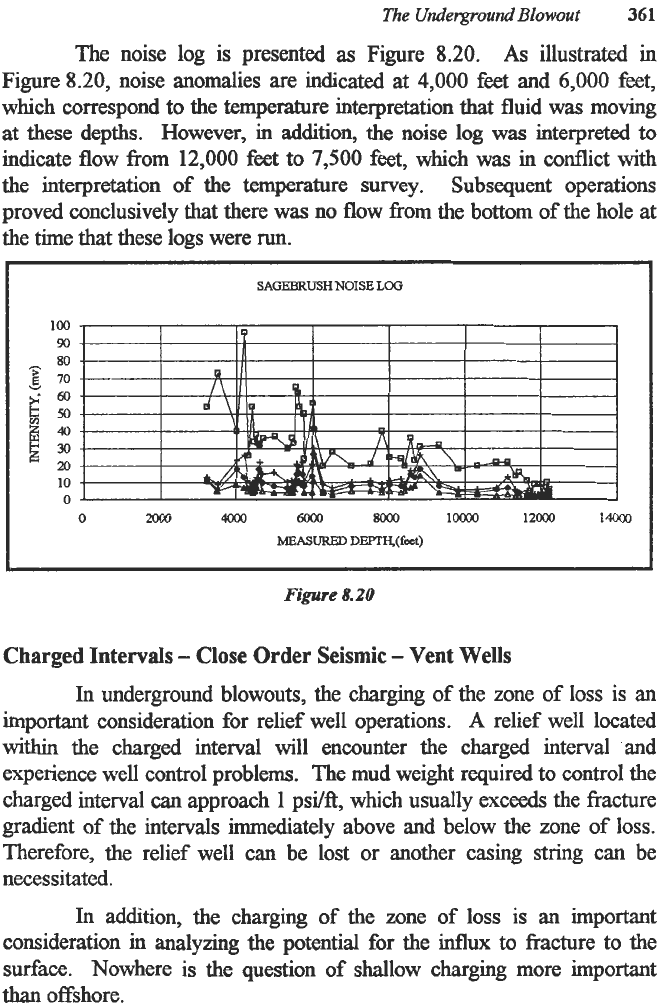
The
Underground
Blowout
361
As
illustrated in
Figure 8.20, noise anomalies are indicated at
4,000
feet and
6,000
feet,
which correspond to the temperature interpretation that
fluid
was moving
at these depths. However, in addition, the noise log
was
interpreted
to
indicate flow from 12,000 feet to
7,500
feet, which
was
in conflict with
the interpretation of the temperature survey. Subsequent operations
proved conclusively that there was no flow from the bottom of the hole at
the time
that
these logs were
run.
The noise log is presented
as
Figure 8.20.
SAGEBRUSH
NOISE
LOG
Figure
8.20
Charged Intervals
-
Close
Order
Seismic
-
Vent Wells
In
underground blowouts, the charging of the zone of
loss
is
an
important consideration for relief well operations.
A
relief well located
within
the charged interval will encounter the charged interval and
experience well control problems. The mud weight required to control the
charged interval can approach 1 psi/ft, which usually exceeds the fracture
gradient of the intervals immediately above and below the zone of loss.
Therefore, the relief well can be lost or another casing string can be
necessitated.
In addition, the charging of the zone of loss is an important
consideration in analyzing the potential for the
influx
to
fracture to the
surface. Nowhere is the question of shallow charging more important
than
offshore.

362
Advanced
Blowout
and
Well
Control
In
late September, 1984, Mobil experienced
a
major blowout at
its N-91 West Venture gas field, offshore Nova Scotia,
Canada.
A
relief
well, the
€3-92,
was spudded approximately
3,000
feet from the blowout.
During drilling
at
2,350
feet with conductor set at
635
feet,
a
gas kick was
taken.
The gas zone encountered was the result of the charging caused by
the N-91 blowout.
A
shallow seismic survey was conducted
to
assist in
defining the extent of the underground charging. Booth reported
that,
when the seismic
data
was
compared with the original work,
two
new
seismic events were identified.' The deeper event occurred at about
2,200
to
2,300
feet, which corresponded
to
the charged zone in the relief well.
However, there was also
a
second event
at
approximately
1,370
to 1,480
feet. The upper interval was interpreted to be approximately
3,300
feet in
diameter emanating from the N-91.
This
event was of great concern since
only unconsolidated sandstones, gravels and clays were present between
the charged interval and the
ocean
floor 1,100 feet away.
Fortunately, the charged interval never fractured
to
the surface.
Eight additional surveys were conducted
between
5
November, 1984 and
9 May, 1985. Those surveys revealed that the gas in the shallow zone
had
not grown significantly since the first survey and
had
migrated only
slightly up dip.
In
addition, the surveys were vital for the selection of safe
areas for relief well operations. Finally, the surveys were vital in
analyzing the safety and potential hazard of continuing operations
onboard the Zapata
Scotain
with the rig on the blowout.
In
the past, it
has
been customary
to
drill vent wells into the
charged zones in an effort
to
reduce the charging. Generally, such efforts
have not proven successful. The zones of
loss are normally not good
quality reservoir. Therefore, the amount of gas being lost greatly exceeds
that
recovered from the vent wells. The result is that the charging
is
relatively unaffected by the vent wells.
At the
TXO
Marshall,
for
example,
three
vent wells were
completed. The blowout
was
discovered to be losing approximately 15
mmscfpd underground. The
three
vent wells were producing
a
total of
less
than
2
mmscfpd. Experiences such
as
this
are commonly reported.
If charging is a problem, the better alternative may
be
to vent the
blowout at the sulface. If charging is to be affected,
the
volume of gas
vented would have to be sufficient
to
cause the flowing surface pressure to
be less than the shut-in surface pressure plus the frictional losses between
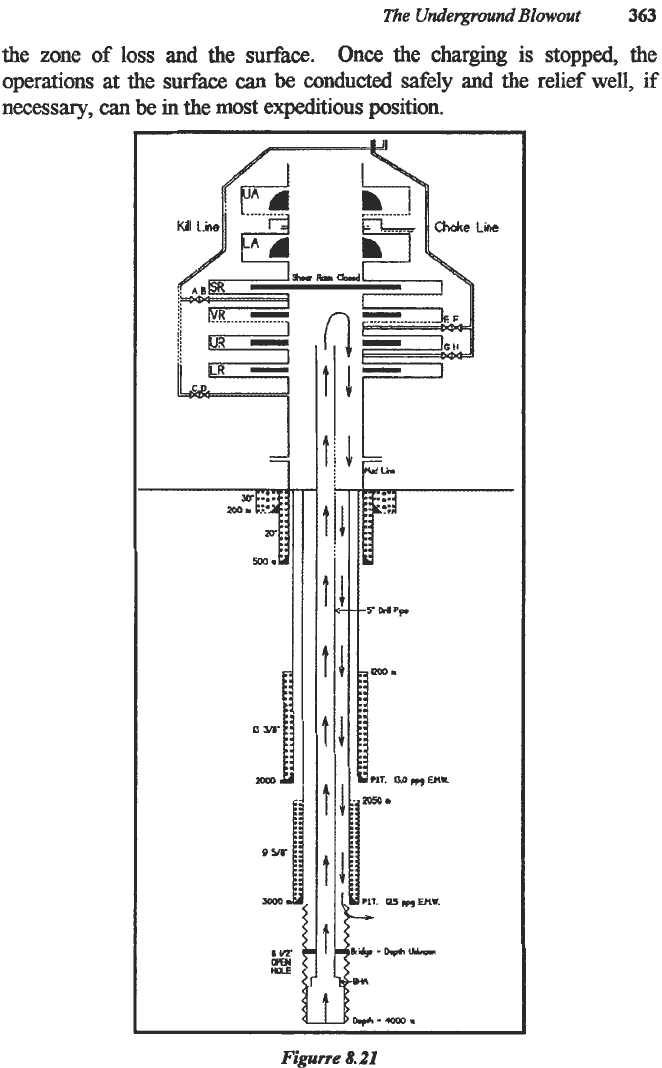
The
Underground
Blowout
363
the
zone of loss
and
the surface.
Once
the charging is stopped,
the
operations at
the
surface
can
be
conducted
safely
and
the
relief well,
if
necessary,
can
be in the
most
expedrtious position.
J
1
1
1
1
t
t
I
t
t
~ ~ ~~
Figurre
8.21
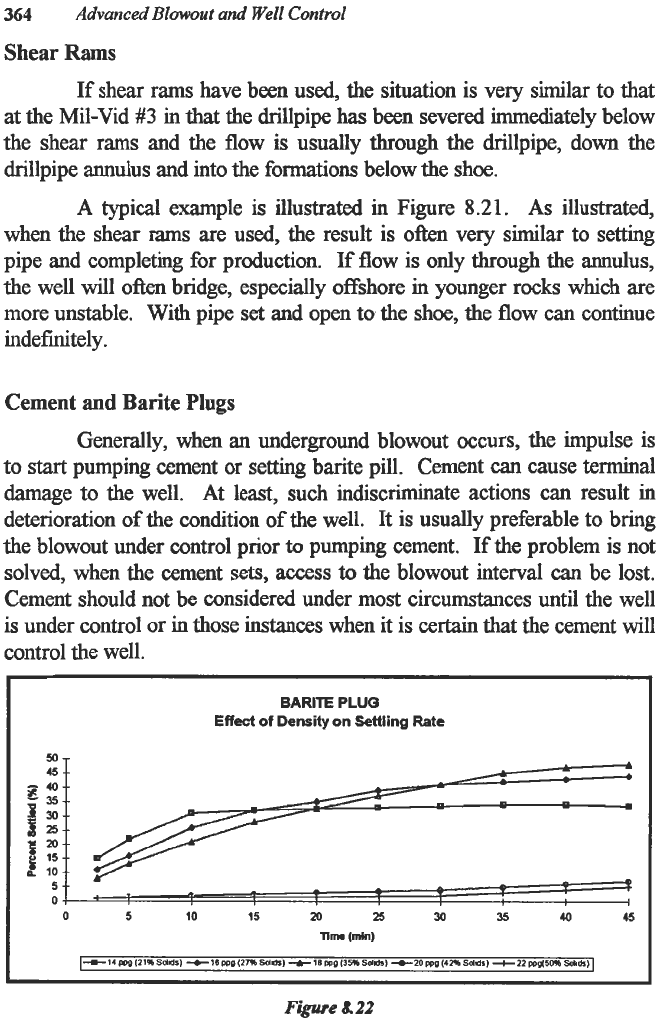
364
Advanced
Blowout
and
Well
Control
Shear
Rams
If shear rams have been used, the situation
is
very similar to that
at the Mil-Vid
#3
in that the drillpipe has been severed immediately below
the shear rams and the
flow
is usually through the drillpipe, down the
drillpipe annulus and into the formations below the shoe.
A typical example is illustrated in Figure
8.21.
As illustrated,
when the shear
rams
are used, the result is
often
very similar to setting
pipe and completing for production. If flow is only through the annulus,
the well will
often
bridge, especially offshore in younger rocks which are
more unstable. With pipe set
and
open to the shoe, the flow can continue
indefinitely.
Cement
and
Barite
Plugs
Generally, when
an
underground blowout occurs, the impulse is
to
start
pumping cement or setting barite pill. Cement
can
cause terminal
damage to the well. At least, such indiscriminate actions can result in
deterioration of the condition of the well. It is usually preferable to bring
the blowout under control prior
to
pumping cement. If the problem is not
solved, when the cement
sets,
access
to
the blowout interval
can
be lost.
Cement should not be considered under most circumstances until the well
is under control or in those instances when it is certain that the cement will
control the well.
I
BARITE
PLUG
Effect of
Density
on
Settling
Rate
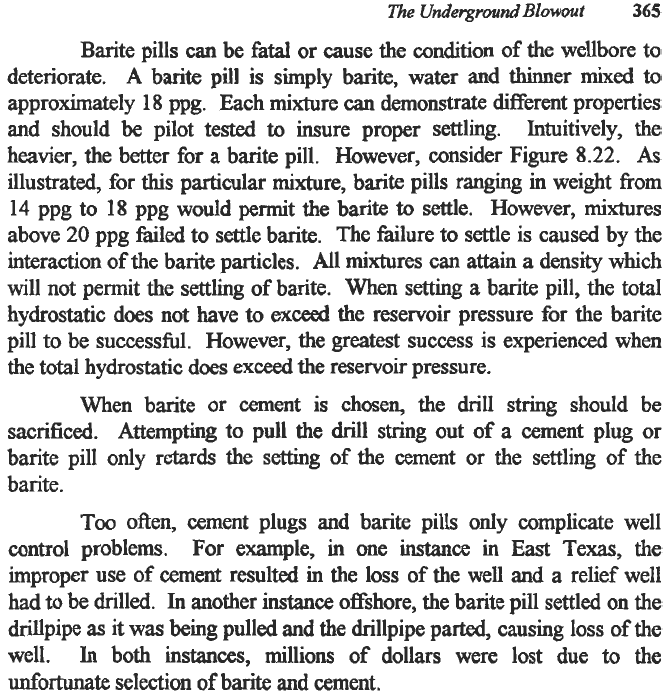
The
Undeqround
Blowout
365
Barite pills
can
be
fktal
or
cause the condition of the wellbore to
deteriorate.
A
barite pill
is
simply
barite,
water
and
thinner
mixed
to
approximately
18
ppg. Each mixture
can
demonstrate different properties
and should
be
pilot tested
to
insure proper settling. Intuitively, the
heavier, the better for
a
barite pill, However, consider Figure
8.22.
As
illustrated, fir
this
particular
mixture,
barite pills ranging in weight
from
14
ppg
to
18
ppg would permit the barite
to
settle.
However,
mixtures
above
20
ppg failed
to
settle barite. The failure to settle is caused by the
interaction
of
the barite particles. All mixtures can attain
a
density
which
will
not
permit the settling
of
barite. When setting
a
barite pill, the total
hydrostatic does
not
have
to
exceed
the reservoir pressure for the barite
pill
to
be successfid. However, the greatest success is experienced when
the total hydrostatic does exceed the reservoir pressure.
When barite or
cement
is
chosen,
the drill string should be
sacrificed.
Athr@ng
to
pull
the
drill
string
out
of
a
cement plug or
barite pill only retards the setting
of
the cement or the settling of the
barite.
Too
often,
cement plugs and barite pills only complicate well
control problems.
For
example,
in
one
instance
in
East
Texas, the
improper use of
cement
resulted
in
the loss
of
the well and
a
relief well
had
to
be drilled.
In
another
instance
offshore, the barite pill settled on the
drillpipe
as
it was being pulled
and
the drillpipe parted, causing loss
of
the
well.
In
both
instances,
millions of dollars were lost due
to
the
unfortunate
selection
of
barite and cement.
